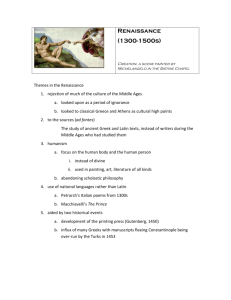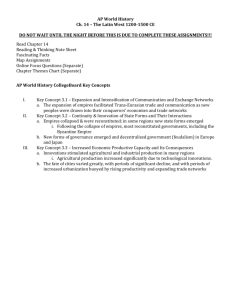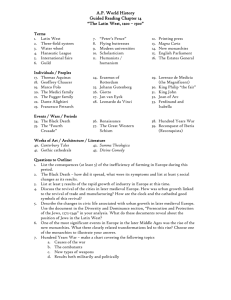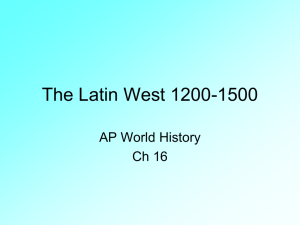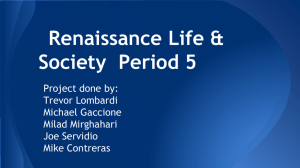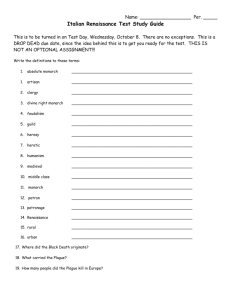Ch14
advertisement
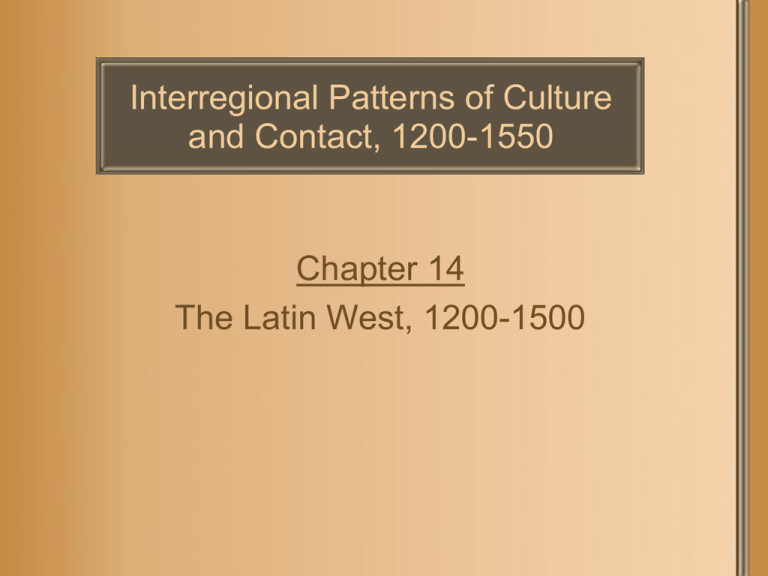
Interregional Patterns of Culture and Contact, 1200-1550 Chapter 14 The Latin West, 1200-1500 Objectives • Be able to analyze the causes and consequences of Europe’s fourteenth-century demographic disaster. • Be able to describe and explain the significance in world history of technological development and urbanization in the Latin West in the later Middle Ages. • Understand the ways in which the intellectual developments of the later Middle Ages reflected Westerners’ views of themselves and their relationship to the past. • Understand the ways in which the Hundred Years War and the emergence of the “new monarchies” laid the foundations for the modern European state system. The Later Middle Ages • 1200 - 1500 CE • European Issues – – – – Muslim invasions lack of European unity Black Death Hundred Years War • European Progress – material prosperity – effects of war – ‘Latin West’ identity • Christianity • competition • technology / learning Rural Growth and Crisis Rural Europe – 9/10 rural – tough on peasants • Serfdom – % of harvest & labor – motivation / inefficiency • Women – inferior to men – “image of God is found in man” • Farming transition – warming climate – 3-field system & harness Rural Growth and Crisis Populations Issues – equals China by 1300 – Latin growth to east – exceeds farm production • climate / war • 30-35 year life span Black Death – 1347-1351 CE – death within days – 1/3 of Western Europeans – recovery by 1500 CE The Black Death Black Death Rural Growth and Crisis Social Result – laborer demand for higher wages • bought land with wages – peasant revolts – disappearance of serfdom • shift from manor to cities – rise in per capita production • overall contraction Rural Growth and Crisis ‘Industrial Revolution’ • borrowed technology – watermills • cog in iron metallurgy • rise in mining – windmills • building booms – stone quarrying Environment – – – – damming of rivers quarry pits and mines river pollution deforestation Urban Revival Trading Cities – growth of trade and manufacturing after 1200 – N. Italy and Flanders • Venice and Genoa • Hanseatic League • Belguim • Italian Trade – Constantinople - 1204 • Black Sea trade – Mongol expansion west • far east trade • Marco Polo - 1271-1295 • European trading fairs – textile industry Urban Revival Civic Life – social freedom • independent states – adaptation to changing markets (autonomy) – social mobility • residents claim freedom – Jewish ‘homeland’ • business skills • persecution – Christian Church • Guilds – trade specialists (union) – dominate civic life Urban Revival Guild Duties – regulate business practices – regulate prices – trained apprentices – women members • Jewish discrimination Merchant Bankers – money changing & loans – church and state • tithes and war loans – Florence & Augsburg – Jewish money-lenders Urban Revival Gothic Cathedrals – 1140 CE – competition • pointed arch • flying buttresses – height and light – stained glass Clock – time-keeping • China water clock – 1st regular use in urban life • tower • church steeple The Renaissance Renaissance – “rebirth” in N. Italy – 12th century urban renewal • universities • intellectual and artistic • Scholarship – ancient Greek and Arabic • S. Italy, Sicily, & Toledo – Jewish translation – monasteries • Dominicans / Franciscans – modern universities • degree granting The Renaissance Universities – 80 by 1500 CE • Oxford and Cambridge – often formed by guilds • apprentice • master / doctor – Latin • fluidity of movement – specialty • medicine, law, theology • “queen of the sciences” • scholasticism – synthesis of philosophy with Biblical truth • Summa Theologica The Renaissance Literature – ‘The Divine Comedy’ • Dante Alighieri – ‘Canterbury Tales” • Geoffery Chaucer • vernacular – local or regional language – larger audience • humanists – literary movement • philosophy and ethics – Greco-Roman classical themes – reforming of secondary education The Renaissance Humanists – mastering of Greek and Latin • Vatican Library • corrections of copyists Printing – movable type – new ink – printing press • Johann Gutenberg • Gutenberg Bible - 1454 – rise in literacy – access to ancient texts The Renaissance Artistic Influence • style – replace stiff w/ natural – identifiable emotions • technology – linseed oil • subject – mythical tales – everyday life • patronage – wealthy • de’ Medici – prelates • Rome as papacy Political Transformation Monarchs – hereditary – limited treasuries – noble rights Nobles – landed – advise and consent Church – independence Cities – independence – economic influence Military Transformation Technology – crossbow • metal-tipped arrows • professional position – firearm Papal / Monarch Politics – Pope Boniface • papal bull of 1302 – King Philip IV • Avignon (1309) • loss of papal neutrality – Great Schism • 1387-1405 CE • rival papal claimants The Great Schism Royal Authority France – King Louis IX • royal courts; bypass noble consent – King Philip IV • creates 3rd estate: weaken nobles/church England – King John ‘Softsword’ • Magna Carta - 1215 – subject to law – nobleman rights – Church independence • State boundaries Hundred Years War Hundred Years War – 1337-1453 CE – marriage alliances – French king and vassals • Edward III • military influences – French crossbowmen – English longbowmen – cannon fire • Battle of Agincourt - 1415 – Joan of Arc • Battle of Orleans - 1429 • 1453 truce Hundred Years War New Monarchies Centralization of Power – British Isles – French nobles • knights ‘outgunned’ • professional military – nobles, merchants, church ‘National’ Boundaries – incorporation Representative Institutions – England • Parliament - 1500 CE – France • Estates General Iberian Unification Reconquista – Iberia from Muslim rule • Toledo - 1085 • Lisbon - 1147 • Cordoba - Seville - 1249 – expanding Christianity • Marriage - 1469 – Isabella of Castile – Ferdinand of Aragon • Granada - 1492 • expulsion – Jews and Muslims
